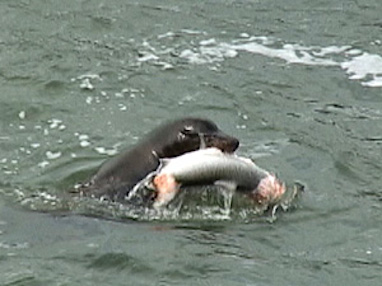Technical Recommendation 14
Predation
Issue
Along with competition, migration and immigration, predation is a keystone agent that controls fish population dynamics. Although predation is a naturally occurring population control agent, management becomes necessary in a highly modified environment such as the Columbia River Basin. Since the publication of the Spirit of the Salmon Plan in 1995, an alarming increase in predation of salmon, lamprey and juvenile sturgeon by birds, marine mammals and other fish has occurred (Rieman et al. 1991; Collis et al. 2002; Evans et al. 2012; Stansell et al. 2010). In the basin, newly created habitat from dredge spoils increased predacious bird populations; a lack of historical primary food sources brought more hungry sea lions upriver; and changes in the flow regime and the introduction of exotic species gradually expanded predacious fish populations. These negative changes in avian, mammalian and fish species population dynamics have tipped the predator/prey balance to the point that active management is required to rebalance predator populations and reduce salmon, lamprey and sturgeon losses.
Avian predation refers to predation by piscivorous (i.e., fish eating) birds on salmonids. Key avian predator species in the Columbia Basin include double-crested cormorants (Phalacrocorax auritus), Caspian terns (Hydroprogne caspia), California gulls (Larus californicus) and ring-billed gulls (Larus delawarensis). The abundance and distribution of double-crested cormorants and Caspian terns has increased dramatically in recent years, from a few hundred to tens of thousands in a less than 20 years (Roby et al. 2012). In 2011 the combined loss was approximately 23 million smolts (BRNW 2012). Smolts may also be subject to predation by marine seabirds off the Pacific coast. Estimates of these oceanic predators are upwards of a hundred thousand birds or more (Fredricks personal communication 2013).
Marine Mammal predation is a growing problem in the lower Columbia River. A California sea lion (Zalophus californianus) population and its impacts on listed salmonids (Oncorhynchus spp.) have increased dramatically at Bonneville Dam over the last decade. So much so that in 2008 National Marine Fisheries Service granted the states of Oregon, Washington and Idaho authority to lethally remove nuisance California sea lions under section 120 of the Marine Mammal Protection Act. CRITFC estimates that over 33,000 Endangered Species Act-listed spring chinook have been taken by California sea lions over the last decade. Since 2009 the Steller sea lion (Eumetopias jubatus) population in the Columbia River has also increased. In 2012 Steller sea lion predation at Bonneville Dam exceeded that of California sea lions. California sea lion abundance is estimated at 296,750 animals (Carretta et al. 2011), which indicates a robust and expanding population. California sea lions are present year round in Bonneville pool.
Fish predation (i.e., fish on fish predation) is well studied or barely studied, depending on the species of predator. Baseline research efforts in the John Day reservoir on the Columbia River in the 1980s identified the northern pikeminnow (Ptychocheilus oregonensis), a native fish,as a significant predator of salmonid smolts, along with non-native walleye, smallmouth bass and channel catfish (Vigg et al. 1991). Estimates of smolt predation were in the millions, with most eaten by northern pikeminnows, which are not protected as a game fish by the states of Oregon and Washington. An intensive government-sponsored public control program on northern pikeminnows was initiated in 1990 and continues in 2013. The program has removed nearly 4 million pikeminnow from the Columbia and Snake rivers. Management action to remove non-native piscivorous fishes has not been taken, although sufficient information confirms their direct and indirect impacts on salmon (ISAB 2008). In 2013 Washington State, however, removed the catch size and daily limits on catfish, walleye and smallmouth bass on selected areas of the Columbia and Snake rivers and their tributaries upstream of McNary Dam.
Hypothesis and Needed Actions
Active management will keep predators at a level that is more in balance with the environment and reduce losses of Columbia River salmon and other native fish populations. To achieve this, the following actions must be taken.
- Develop a common metric for fish, bird and marine mammal predation (i.e., adult equivalents) so that comparisons and impacts can be properly assessed.
- Investigate, monitor, evaluate and propose solutions to habitat changes at Columbia River tributary confluences where hydrologic modifications have resulted in increased sediment deposition and potentially attracted predator responses.
- Investigate indirect food web effects of predation.
- Apply active, adaptive management practices to predation sources.
- Pursue legislative solutions to barriers preventing active management.
- Persuade co-managers to prioritize salmon management in anadromous waters and remove barriers to harvest non-native fish species.
- Focus public outreach on benefits of native fish communities and balanced ecosystems.
- Develop greater cross-agency cooperation and investigation opportunities.
Expected Outcome
Fewer Columbia River salmon, lamprey and sturgeon will be lost to predators.






